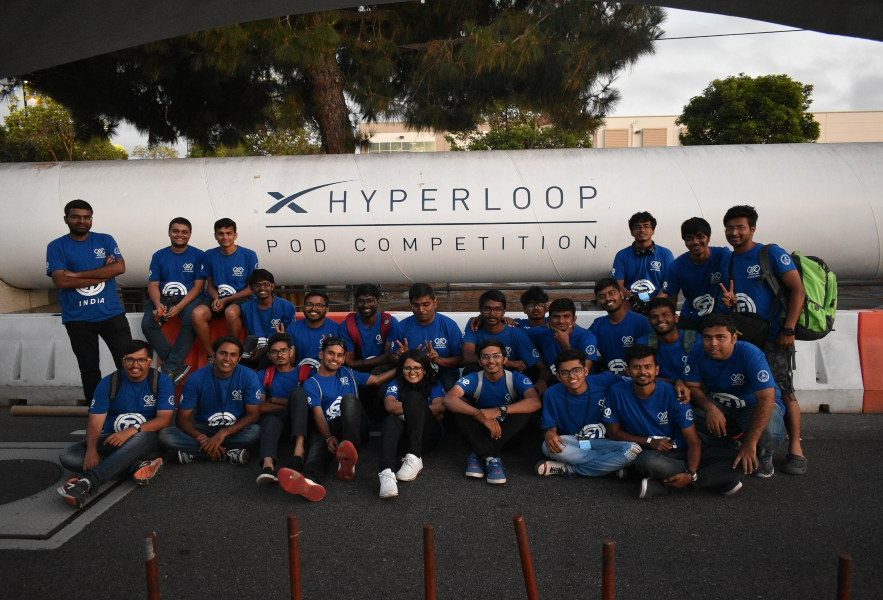
From IIT-Madras to SpaceX, the dream journey of Avishkar Hyperloop

The Avishkar Hyperloop team from Indian Institute of Technology (IIT) Madras, which recently made headlines for making its debut in SpaceX Hyperloop Pod Competition 2019, submitted their final design just seconds before the 10:30 am deadline. Those less than 30 seconds allowed the team to take rapid strides to the finals, organised by Elon Musk’s SpaceX in California on July 21.
“We were looking at the report and it was 10:28 am when we decided to send it. But the attachment was still loading by 10:29 am. We all had our fingers crossed and then we saw it was sent,” Pranit Mehta, a current member and the upcoming Head of Avishkar Hyperloop, told The Federal. Mehta, who is one of the founding members of the team, is now a third-year engineering design student at IIT Madras.
The final design, due on January 13, was the second round of the selection process for the global competition. “We had prepared the final design but the number of pages were more than the limit of 120 pages. So, we had to bring it down to 120 pages, which took some time,” Aditya Ranade, a member of Avishkar Hyperloop and a fifth year BTech (Civil Engineering) student, told The Federal.

The team, which returned to India on July 29, recalled how everyone had sleepless nights before the final submissions. The team designed the first-ever self-propelled, completely autonomous Hyperloop pod in India.
The student-run Avishkar Hyperloop team from the Centre for Innovation (CFI) at IIT Madras was the only finalist from Asia at the competition. The team made it to the finals in their second attempt. The achievement solely reflects the passion of each of the 27 students who came together from different departments to execute the project.
Also read: From wacky and pseudo to cutting edge, Indians probe the limits of science
Team Avishkar Hyperloop was one of the top 21 teams out of the 1,600 plus participants from across the world.
The team was initially started by three students in 2017. With time, more students joined in but the team could not clear the second round that involved a submission of the final design in 2018. However, three members got an opportunity to go to the SpaceX Hyperloop Pod Competition 2018 and see how teams across the globe were working. This offered them an opportunity to identify where they were going wrong.
“In the first year, none of us had prior experience working on it and it was hard to coordinate time,” Ranade said. He was one of the three members who attended the SpaceX Hyperloop Pod Competition in 2018. “Our approach during the first time was a bit too high-tech and hard to execute,” Ranade added.
So this time, the team focused on designing hyperloop pods that were feasible. “This year, we focused on keeping our pods design feasible and not so innovative that people find hard to believe,” Mehta said.

It is important to come up with innovative designs that are achievable because unless people are convinced that the project will work, they will not fund it, Mehta explained.
Avishkar Hyperloop cleared more than half of the nearly 120 tests held during the final round. While the team’s performance was good, it could not make it to the last four teams, who got an opportunity to test their working models.
Also read: Elon Musk shows off progress on brain-machine interface
Looking back at the journey, both Mehta and Ranade credited the team’s hard work and dedication for the success. On an average, each member worked for about 10-15 hours a week on this project. “As we got closer to the deadline, people started working for nearly 20 hours a day,” Mehta said.
The fact that the team had already worked together for a year helped them resolve their management and coordination issues. “We gathered every evening around 7 pm and worked till 10 pm. This gave people sufficient time for sports and other curriculum activities,” he added. With time, the students also learned how to manage their academics.
The team worked even during their internships and holidays. After sending preliminary designs in July 2018, the list of teams which qualified for the second round was announced in November. However, by that time most people had taken up internships and many had plans to go home during holidays in December. Thus, the team had less than a month to send the final design that was due in January.
“Last December, however, about 12 students stayed back during the Christmas holidays to work on the project. They worked really hard,” Ranade said.

Every round is crucial as SpaceX would eliminate a few teams in each round. Luckily, the final design got uploaded just seconds before the deadline and the team qualified for the third round that also consisted of an interview.
After the Avishkar Hyperloop team cleared the third round, SpaceX allotted them three advisers who guided them through technical aspects and looked at their progress.
“Last year, it was like we were finding our way in the dark because we had no idea. But the feedback we received from SpaceX helped us a lot,” Ranade said.
Even though the team did not make it to the top four slots, the students gained exposure during their first-ever final that would help them in the coming editions of this event.
“The project will continue until the competition goes on,” Ranade said. After the final year students graduate, the team brings in students from first year to fill their space so that the work on the project continues.
Owing to the team’s achievements this year, many first year students have already started showing interest in being a part of the team. “Last year, we ourselves had to bring students into the team. But now, some first year students are themselves willing to join us,” Mehta said.

